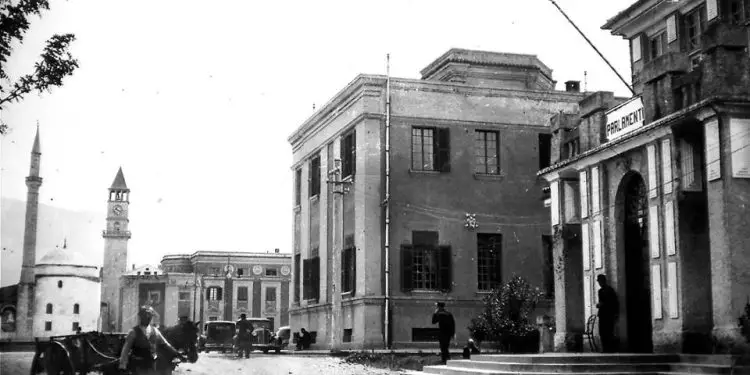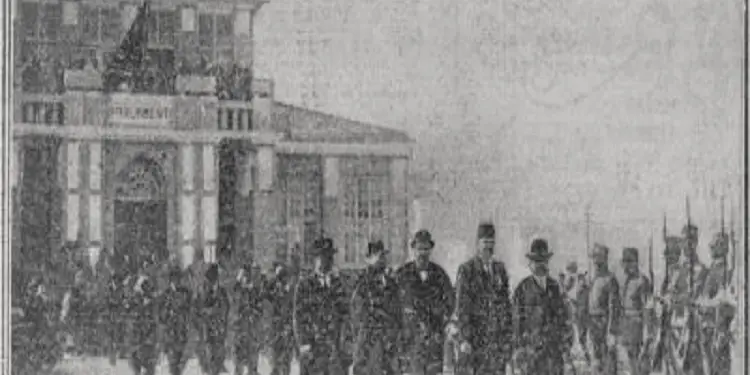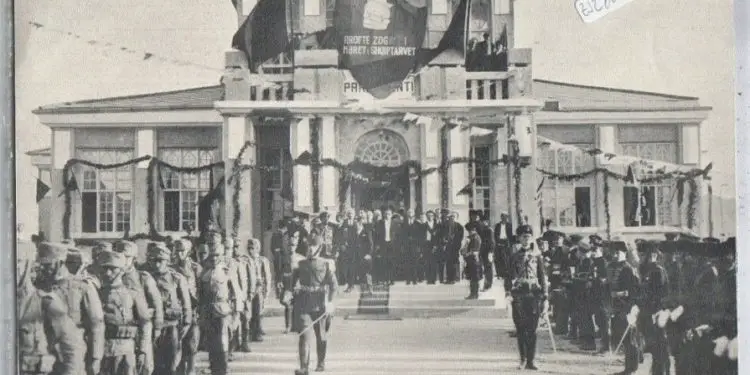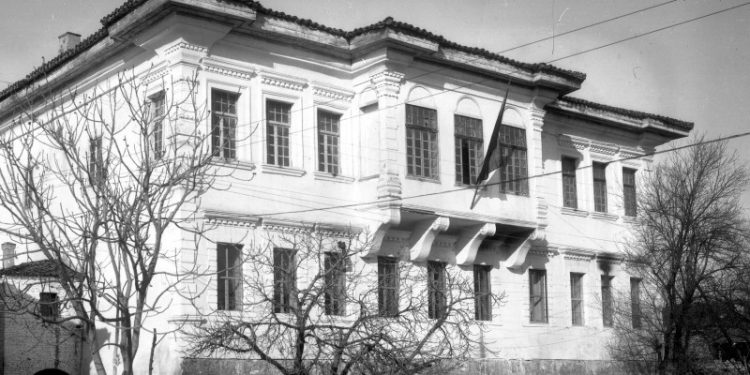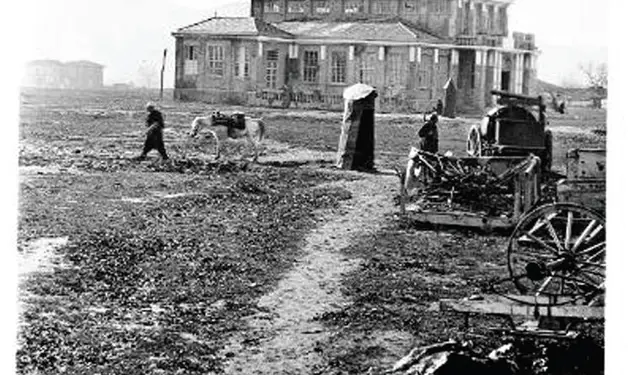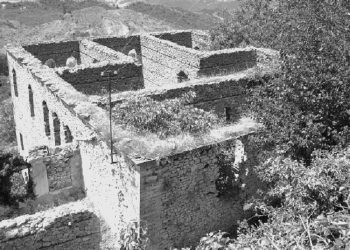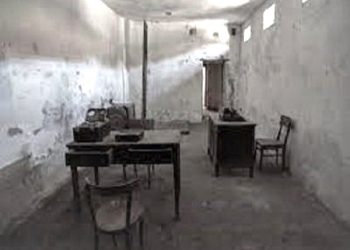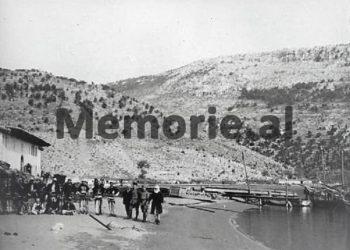From Qerim Vrioni
-In “search” of a commemorative plaque, for the first Albanian Parliament-
Memorie.al / A few years ago, I accompanied an Italian friend around Vlora, especially in the symbolic points of the city. So, after Kuzumbaba, we went to Kanina, to the Museum of Independence, to the “Flag Square” complex, the resting place of Ismail Qemali, the Obelisk of the Flag, the Independence Monument, we visited Zvrnec, etc. Towards the end of my stay in the city, my satisfied friend asked me to show him the oldest house in Vlora. Of course he thought that, in addition to the designation, it would also have a small bronze plaque on one of its walls to roughly mark its age. I shrugged, not knowing how to give him the correct answer.
The Italian began to list the reasons why the definition of the earliest house (or one of the oldest houses) of the historical city (but also of any other city) was necessary. The commemorative plaques, according to him, were evidence of a developed life with political, social, cultural, religious activity, etc., of a city or inhabited center.
I didn’t have anything more to say to my friend and, somewhat tight-lipped, I tactfully changed the “rails” of the conversation. Especially, I was surprised when he said that; the history of a city (even the state – I added with my mind) is also made up of old buildings, even with them it is directly affected.
A few years after that, dealing with “Albanian Photography”, I passed through my hands many historical photos of the country, since the beginning of the last century.
Among them, the photos of the celebration of the first anniversary of the Declaration of Independence in Vlora, which reflect the arrival of the Government (the Regency as it was called then), elected by the Congress of Lushnja (January 21-31, 1920), in Tirana (February 1920), in the newly designated capital, and a few years later, photos of the new parliament with several deputies, handsome men, before its entrance.
The latter, taken from the cameras of well-known photographers of the time, such as; Kel and Gegë Marubi, Ymer Bali, Shan Pici, Kole Maca, etc. In the central part of the building’s facade, it was then written in large letters capital: “PARLIAMENT”.
The National Council (Parliament) elected by the Congress of Lushnja, “gathered in the first session in Tirana at the house of Zija bey Toptan”, which was temporarily transformed into the seat of the Albanian Parliament.
In 1925, this Council, now composed of two chambers, the Senate and the Chamber of Deputies, moved from this house to the building that served the Albanian Parliament until 1944.
After this year, the building had several functions, until during the period 1996-2000, it returned to the headquarters of the Municipal Council of Tirana (at last, a function similar and legitimate to the origin).
After this year, the Puppet Theater was established there…! Afterwards, there was enough whispering to turn it into a Museum of Albanian Parliamentarianism” (as they have long since turned the Government Seat of Ismail Qemali into a Museum of Independence in Vlora), but no, they even intervened, damaging the old building “. (From “Gazmend Bakiu — ‘Old Tirana’ – Tirana, 2013”).
Behind Ismail Qemali’s Government building (March 1913-January 1914) in Skela, where, as mentioned, today is the Museum of Independence (a well-deserved tribute to history), the former Parliament of that time, (today the Puppet Theatre), as far as we know, remains until now, the headquarters of the oldest Albanian state institution in our country.
For this reason, I think this building should have a special treatment from the Albanian state, for respect, but also to distinguish it from the many other buildings of Tirana.
It is not being requested to relocate the Puppet Theater (perhaps this could also be done), but at least to recognize the building with special architecture as the place where, for the first time, the Albanians themselves laid the foundations of their modern state, on international legal bases and patriotic spirit.
Also, we don’t know exactly (sorry for the lack of knowledge) whether or not this old building is in the architecturally protected area of the capital, and if not, I don’t think there should be any good reason for it.
In fact, the Seat of the first Parliament, not only does not have a commemorative plaque, (there is no mistake if it is placed), but it is very rarely mentioned in the press, or in publications with its original function, which gives place to aside, among many old and new buildings of Tirana.
For the lack of this plaque, all the ministers of culture of the Albanian governments after 1991 do not deserve “praise”. Likewise, the presidents of the Assembly of Albania (successor of the first Parliament), always from the years after the overthrow of the communist dictatorship.
By lowering the “stake” of responsibility even lower, the Directors of the Institute of Cultural Monuments cannot be criticized. Of course, historians with scientific degrees and many honorary titles are not out of hand in this unpleasant (in my opinion) state of the building. Sometimes failure to act at the right time is a mistake with consequences for the future…!
This year, this building that for a long time (almost 20 years) has functioned as the first Albanian Parliament, turned a century old, and probably deserves, at least, a small bronze plaque with a few words, such as ; “Historical Monument – Protected by the State”, or even; “The first Albanian Parliament held its work here from 1923 to 1939”.
Perhaps from the economic point of view, the installation of a bronze plate does not require the development of a tender….?! Thus, the historical memory of Tirana, which the new constructions are reducing at a fast rate, will continue to remain an important object with indisputable values, for generations to come.
The preservation of the old buildings of the country (which, generally, are (not earlier than a century and a half), on their own merits, which, for the sake of truth, are not a large number, will not permit even the enlargement further of “Lost Albania”, (according to an expression of Ylli Polovina).
Near and around the building of the Puppet Theater, buildings with “high heels” have been erected, and it seems they will continue in the future, but the value and charm of the two-story building (despite the floral colors of its facade) of In the first parliament, they hardly reach it. This is because its historical status is irreplaceable and cemented, even after almost 100 years of life. Memorie.al




